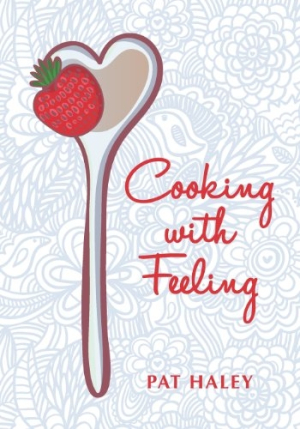Cooking with Feeling
As her mother often told her, “Never ignore a good impulse.” Pat Haley showcases this commonsense advice in Cooking with Feeling. Alongside easy everyday recipes, Haley includes an essay with each chapter. Part historical overview and part memoir, most chapters are extremely entertaining.
Haley’s writing is crisp and clean with a warm tone. Her many beautiful descriptions detail how she was first introduced to cooking, and how her cooking is best when shared with her husband, Edward, and their community of friends and family. At the end of the chapter on coffee, her prose shines: “Just lead me to a barrel of fresh Kona beans and let me inhale. This is ecstasy. It evokes in me the memory of a mother’s love. And the progressive excitements of high tech hardware bringing on quicker, better brews. And the right-at-home perfumes of beans I can grind myself. And the first sip of French roast warming the dark of a winter morn. And the fragrance of decaf after a dinner with friends. And the Sufis dancing in their enchantment. I know the feeling.”
Some of the chapters’ subjects are expected—there is one on potatoes and another on the garden—while others are quite original and may challenge some home cooks. One such chapter, “Food in Bloom,” advises readers on how to use edible blossoms from their gardens for culinary purposes. It includes recipes such as candied violets and ice cream made with champagne and rose petals. Another unusual chapter teaches readers how to use juniper berries in recipes the author has collected from around the world.
For the most part, Haley’s chapters are easy to read and extremely informative. In the chapter on pears, she not only shares that Louis XIV declared the pear to be his favorite fruit, and that new varieties were produced “for His Majesty’s pleasure,” but she also explains the best way to ripen a pear and notes the characteristics of each commercial variety. All the while, Haley describes her own cooking stories in a humble and endearing voice. She includes beautiful images of her mother canning during the Great Depression, as well as photographs of her own attempts to pass along this practical knowledge to her own children in the 1970s.
Although Cooking with Feeling is, for the most part, written for novice cooks, it includes details that will be intriguing to even the most committed and experimental of chefs. Cooking with Feeling is engrossing while it remains practical. It is a warm-spirited book that concentrates on building community through the heartening act of sharing food.
Reviewed by
Colby Cedar Smith
Disclosure: This article is not an endorsement, but a review. The publisher of this book provided free copies of the book and paid a small fee to have their book reviewed by a professional reviewer. Foreword Reviews and Clarion Reviews make no guarantee that the publisher will receive a positive review. Foreword Magazine, Inc. is disclosing this in accordance with the Federal Trade Commission’s 16 CFR, Part 255.

